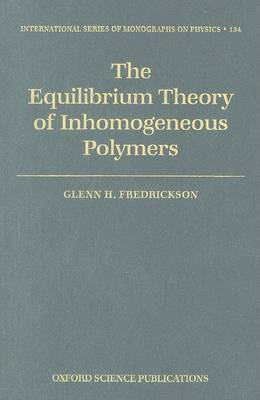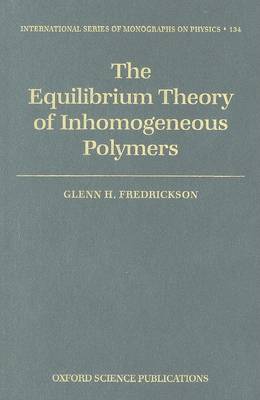
Door een staking bij bpost kan je online bestelling op dit moment iets langer onderweg zijn dan voorzien. Dringend iets nodig? Onze winkels ontvangen jou met open armen!
- Afhalen na 1 uur in een winkel met voorraad
- Gratis thuislevering in België vanaf € 30
- Ruim aanbod met 7 miljoen producten
Door een staking bij bpost kan je online bestelling op dit moment iets langer onderweg zijn dan voorzien. Dringend iets nodig? Onze winkels ontvangen jou met open armen!
- Afhalen na 1 uur in een winkel met voorraad
- Gratis thuislevering in België vanaf € 30
- Ruim aanbod met 7 miljoen producten
Zoeken
Omschrijving
The Equilibrium Theory of Inhomogeneous Polymers provides an introduction to the field-theoretic methods and computer simulation techniques that are used in the design of structured polymeric fluids. By such methods, the principles that dictate equilibrium self-assembly in systems ranging from block and graft copolymers, to polyelectrolytes, liquid crystalline polymers, and polymer nanocomposites can be established. Building on an introductory discussion of single-polymer statistical mechanics, the book provides a detailed treatment of analytical and numerical techniques for addressing the conformational properties of polymers subjected to spatially-varying potential fields. This problem is shown to be central to the field-theoretic description of interacting polymeric fluids, and models for a number of important polymer systems are elaborated. Chapter 5 serves to unify and expound the topic of self-consistent field theory, which is a collection of analytical and numerical
techniques for obtaining solutions of polymer field theory models in the mean-field approximation. The concluding Chapter 6 provides a discussion of analytical methods for going beyond the mean-field approximation and an introduction to the exciting new field of field-theoretic polymer simulations - the direct numerical simulation of polymer field theory models. No other book brings together in such a detailed and instructive fashion the theoretical and numerical tools for investigating the equilibrium structure and thermodynamics of meso-structured polymer formulations, including those relevant to soft material nanotechnologies, personal care products, and multiphase plastic materials.
techniques for obtaining solutions of polymer field theory models in the mean-field approximation. The concluding Chapter 6 provides a discussion of analytical methods for going beyond the mean-field approximation and an introduction to the exciting new field of field-theoretic polymer simulations - the direct numerical simulation of polymer field theory models. No other book brings together in such a detailed and instructive fashion the theoretical and numerical tools for investigating the equilibrium structure and thermodynamics of meso-structured polymer formulations, including those relevant to soft material nanotechnologies, personal care products, and multiphase plastic materials.
Specificaties
Betrokkenen
- Auteur(s):
- Uitgeverij:
Inhoud
- Aantal bladzijden:
- 452
- Taal:
- Engels
- Reeks:
- Reeksnummer:
- nr. 134
Eigenschappen
- Productcode (EAN):
- 9780198567295
- Verschijningsdatum:
- 2/02/2006
- Uitvoering:
- Hardcover
- Formaat:
- Genaaid
- Afmetingen:
- 236 mm x 157 mm
- Gewicht:
- 890 g

Alleen bij Standaard Boekhandel
+ 359 punten op je klantenkaart van Standaard Boekhandel
Beoordelingen
We publiceren alleen reviews die voldoen aan de voorwaarden voor reviews. Bekijk onze voorwaarden voor reviews.











